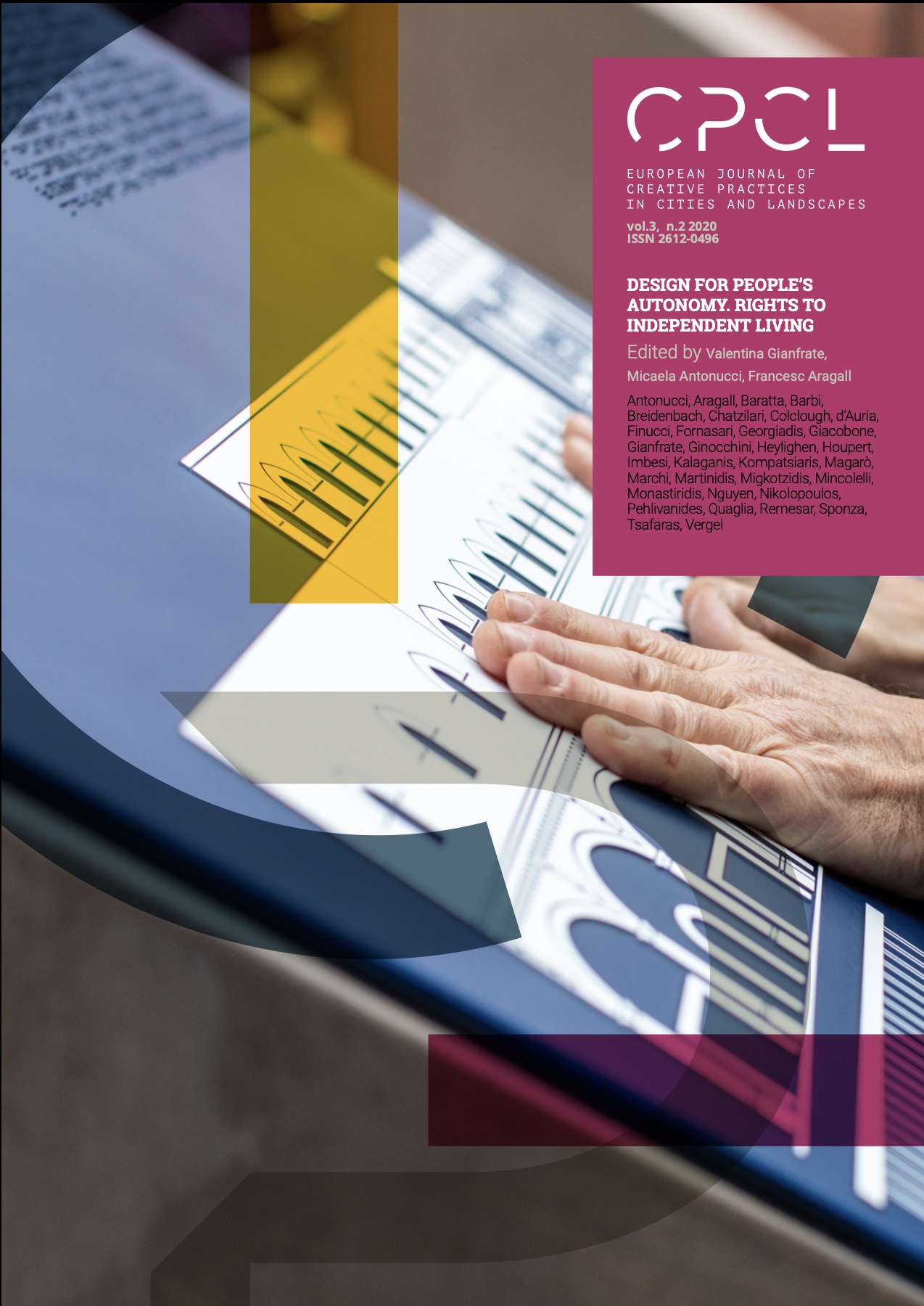Intelligent Domestic Ecosystems: innovative housing models for fragile elderly
DOI:
https://doi.org/10.6092/issn.2612-0496/11498Keywords:
Intelligent Domestic Ecosystems, Fragile users, Housing for Elderly, Active and Assisted Living, Safe and Inclusive HousingAbstract
Fragile users represent a category in which the elderly population is included (fragile elderly). In 2017, there were 962 million people over 60, half the number expected by 2050, and many of them have disabilities. During the recent health emergency, frailty was discriminating for access to therapies creating the risk, not yet evaluated, that the mortality rate of fragile users could be increased.
This is because, even when not infected, the fragile elderly people were denied access to the hospital spaces they needed. The contribution would describe the state of the art and the first results of the research conducted at the Roma Tre University which aims to study innovative housing models for fragile elderly people capable of promoting de-hospitalization avoiding the submentioned risk and improving the quality of life through the technological transfer of the Internet of Things from the ICT sector to the architecture one. First of all, it will define both the final user of the research, i.e. the fragile elderly through its historical genesis, and the tools of the research, i.e. the intelligent domestic ecosystems as new integrated and interconnected housing models. Secondly, it will be described the research core aimed to design a prototype, realized with the use of open source and low-cost technologies.References
AIOTI, Alliance for Internet of Things Innovation, Bruxelles: European Commission (2015).
Ashton, Kevin “That ‘Internet of Things’ thing”, RFiD Journal 12 (2009): 121-128.
Brocklehurst, J. C. and Wagner, E. H. “Preventing frail health”, Clinics in Geriatric Medicine 8 (1992): 1-17.
Brocklehurst, J. C.; Robertson D.; James-Groom P. “Skeletal deformities in the elderly and their effect on postural sway”, Journal of the American Geriatrics Society 30 (1982): 534-538.
Campbell, A. J. and Buchner, D. M. “Unstable disability and the fluctuations of frailty” Age Ageing 26 (1997): 315-318.
Caragliu, A.; Del Bo, C.; Nijkamp, P. “Smart cities in Europe”, Series Research Memoranda 48 (2009): 2-14.
Chourabi B. F. “Modelling e-government business processes: new approaches to transparent and efficient performance” Information Polity Journal 14 (2009): 91-109.
FCA, Federal Council on Ageing “Federal Council on Ageing focuses on frail elderly” Geriatrics 33 (1978): 16-21.
Formica, G. and Magarò, A. “Abitazioni per Anziani: nuove tecnologie per la fruizione dello spazio domestico” in Abitazioni sicure e inclusive per anziani edited by Baratta, A.; Farina, M.; Finucci, F.; Formica, G.; Giancotti, A.; Montuori, L.; Palmieri, V. Conegliano: Anteferma, 2018, 347-356.
Fried, L. P. “Conference on the physiologic basis of frailty. April 28, 1992. Baltimore, Maryland, U.S.A. Introduction”. Ageing 4 (1992): 251-252.
Gabriel, C. S. An overview of nursing home facilities: data from the 1997 National Nursing Home Survey. Advance data from vital and health statistic; no. 311, Hyattsville, Maryland: National Center for Health Statistics, 2000.
Garfein, A. J. and Herzog, A. R. “Robust aging among the young-old, old-old and oldest-old” Journal of Gerontology: Social Sciences 50 (1995): 77–87.
ISTAT “La spesa dei comuni per i servizi sociali. Anno 2017” istat.it. https://www.istat.it/it/files/2020/02/Report-Spesa-sociale-dei-comuni.pdf (accessed July 20, 2020).
Kang, B. “Ubiquitous Computing Environment Threats and Defensive Measures” International Journal of Multimedia and Ubiquitous Engineering 1 (2007): 47-60.
Maddox, G. L. The enciclopedia of the ageing, New York: Springer Publishing Company, 1987.
Magarò, A. “Ergonomia cognitiva negli ecosistemi domestici aumentati per un’utenza fragile”, in Abitare Inclusivo. Il progetto per una vita autonoma e indipendente, edited by Baratta, A.; Conti, C.; Tatano, V. Conegliano (TV): Anteferma, 2019, 340-349.
Magarò, A.; Baratta, A. “Machine Learning e architetture sicure e inclusive per un’utenza fragile” Agathon. International Journal of Architecture, Art and Design 5 (2019): 109-116.
Miguel, J. C. and Casado, M. A. GAFAnomy (Google, Amazon, Facebook and Apple): The Big Four and theb-Ecosystem. InDynamics of Big Internet Industry Groups and Future Trends, Springer: Berlin, 2016.
Minerva, R. “Towards a Definition of the Internet of Things” IEEE Internet Initiative 1 (2015): 1–86.
Ragget, D. “The Web of Things: Challenges and Opportunities” Computer 48 (2015): 26–32.
Rhee, S. “Catalyzing the Internet of Things and smart cities: Global City Teams Challenge”, in Proceedings of the 1st International Workshop on Science of Smart City Operations and Platforms Engineering (SCOPE) inPartnership with Global City Teams Challenge, Vienna, 2016, 1–4.
Samuel, A.L. “Some studies in machine learning using the game of checkers” IBM Journal of Research and Development 44 (1959): 206-226.
Sanchez Chillon, P. (2012). “The thirds rule for the smart city plan: vision & leadership, sound infrastructures and civic engagement (let’s count on digizens)” urban360.me. https://urban360.me/2012/10/13/the-3-thirds-rule-for-the-smart-city-plan/ (accessed July 20, 2020).
Stevenson, O. “The frail elderly – a social worker’s perspective”, in Healthcare of the elderly edited by Arie, T. Baltimore: John Hopkins University (1981), 158-175.
Stolee, P and Rockwood, K. Report of the Saskatchewan Health Status Survey of the Elderly, Saskatoon, Sask: University of Saskatchewan, 1981.
Streib, G. F. “The frail elderly: research dilemmas and research opportunities” Gerontologist 27 (1983): 616-626.
Swetina, J.; Lu, G.; Jacobs, P.; Ennesser, F.; Song, J. “Toward a standardized common M2M service layer platform: Introduction to oneM2M” IEEE Wireless Communications 21 (2014):20-26.
Tavani, C. A staff report – Public policy and the frail elderly, Washington D.C.: US Department of Health, Education and Welfare, 1978.
Vermesan, O. and Fries, P. Digitising the Industry Internet of Things Connecting the Physical, Digital and Virtual Worlds, River Publishers: Delft, 2016.
Weiser, M. “The computer for the 21st Century” Scientific American, Special Issue on Communications, Computers and Networks 9 (1991): 94-104.
Downloads
Published
How to Cite
Issue
Section
License
Copyright (c) 2020 Antonio Magarò, Adolfo Baratta, Fabrizio Finucci

This work is licensed under a Creative Commons Attribution 4.0 International License.




